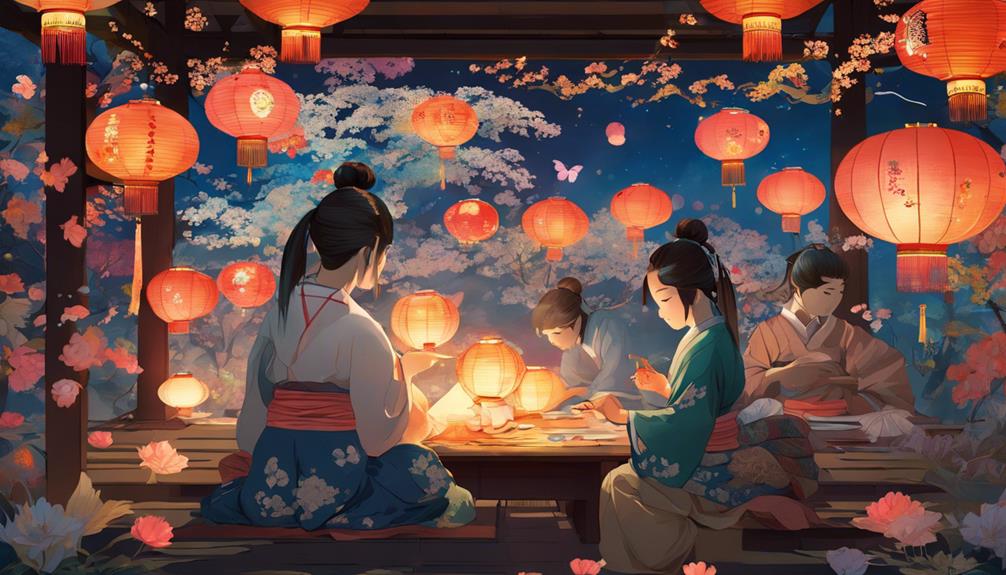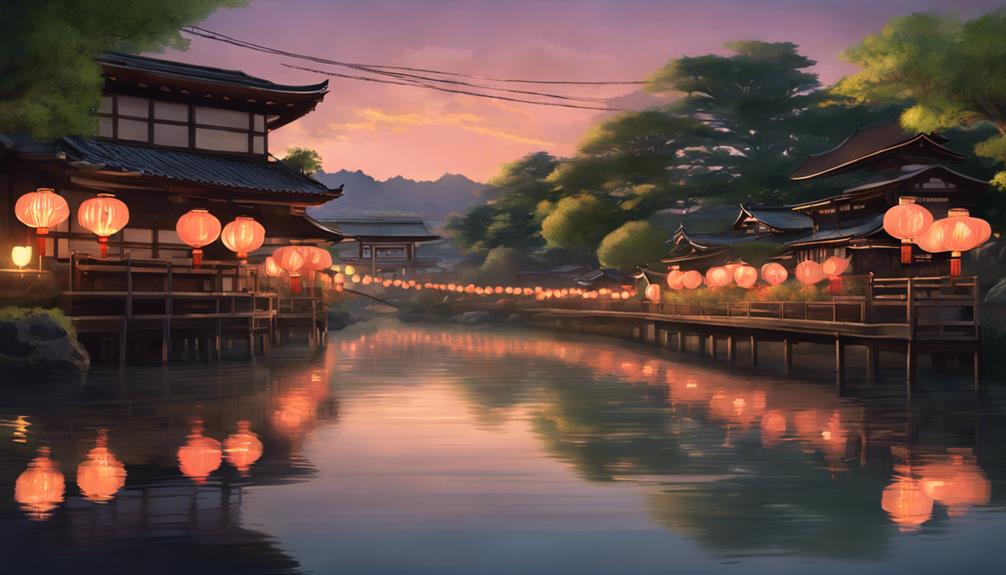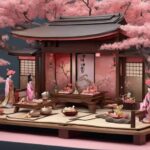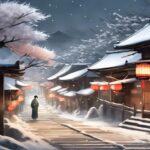Experience the exploration tradition of Toro Nagashi in Japan, where lanterns are floated down rivers to honour departed loved ones in a centuries-old practice linked to the Obon festival. This profound ritual not only pays homage to guiding spirits but also symbolizes the transient nature of life and fosters deep spiritual connections within communities.
Through Toro Nagashi, participants celebrate unity, cultural heritage, and the beauty of remembering loved ones in a meaningful way. Uncover deeper into the history, symbolism, preparations, and modern adaptations of this cherished Japanese tradition to unravel its rich cultural fabric.
Key Takeaways
- Toro Nagashi is a Japanese tradition of floating lanterns down rivers.
- Originates from the Obon festival to honour departed loved ones.
- Represents guiding spirits back to the afterlife and the transient nature of life.
- Symbolizes unity, community bonding, and cultural reverence.
- Held in various locations like Hiroshima, Nagasaki, and Kyoto for remembrance and spiritual connection.
Toro Nagashi Japan At A Glance
| Facts | Brief Explanation |
|---|---|
| Name of the Festival | Toro Nagashi |
| Type of Festival | Religious, Cultural |
| City of Origin | Nara City, Nara Prefecture |
| Festival Etymology | Toro (灯籠, tōrō) means “lantern” and Nagashi (流し, nagashi) means “floating” in Japanese. The festival involves floating lanterns down a river. |
| Date when it was celebrated first | Unknown, but it has been celebrated since ancient times. |
| Dates when this festival is celebrated every year | August 5th to August 7th |
| Founder of the Festival | Unknown, but it is believed to have originated as a Buddhist ritual. |
| Brief history of the festival | The Toro Nagashi festival is a Buddhist ritual that originated in ancient times. It involves floating lanterns down the Okazaki Canal in Nara City to honor the souls of ancestors and guide them to the afterlife. The lanterns are made of wood and paper, and they are decorated with messages and prayers. The festival is a solemn and reflective occasion that brings together the local community. |
| Brief history of the city where it is celebrated | Nara City, located in the Nara Prefecture, was the capital of Japan from 710 to 794 CE during the Nara period. It is home to many significant historical sites, including Todai-ji Temple, which houses the Great Buddha statue, and Kasuga Taisha Shrine. Nara is known for its rich cultural heritage and numerous deer that roam freely in the city. |
| Ethnic information of the city and region | Nara Prefecture has a predominantly Japanese population, with a small number of foreign residents. The region has a rich cultural heritage and is influenced by Buddhist and Shinto traditions. |
| Explain the location of the city in the country | Nara City is located in the Kansai region of Japan, in the southern part of Nara Prefecture. It is situated about 30 kilometers from Osaka and 45 kilometers from Kyoto. |
| Explain concisely how to reach the city | Nara City is easily accessible by train, with direct connections from major cities like Tokyo, Osaka, and Kyoto. The city also has an international airport, Nara Airport, which serves domestic and some international flights. |
| Nearby and surrounding cities or towns and their distance from the city of the festival | – Kyoto (45 km) – Osaka (30 km) – Tenri (15 km) – Kashihara (20 km) – Sakurai (25 km) |
| Google map link to the city location | https://goo.gl/maps/LFb4W5ZKzNHYVYdY6 |
| Bullet list of festival main events and activities | – Floating lanterns down the Okazaki Canal – Prayers and rituals at Buddhist temples – Traditional music and dance performances – Food stalls and vendors selling local delicacies |
| Bullet list of famous tourist attractions and landmarks in the city and one line about them why they are important to the city | – Todai-ji Temple (houses the Great Buddha statue, a UNESCO World Heritage Site) – Nara Park (a large park with free-roaming deer, home to many historical sites) – Kasuga Taisha Shrine (a Shinto shrine known for its lanterns and deer) – Nara National Museum (houses a collection of Buddhist art and artifacts) |
| Famous food dishes of the city | – Narazuke (Nara’s traditional pickled vegetables) – Kakinoha-zushi (sushi wrapped in persimmon leaves) – Miyako-gashi (traditional Japanese sweets and confections) |
| Related festivals in the same region | – Kasuga Wakamiya On Matsuri (Nara, April) – Kifune Matsuri (Kyoto, October) – Gion Matsuri (Kyoto, July) |
History of Toro Nagashi
The tradition of Toro Nagashi in Japan dates back centuries, originating as a way to honour and remember departed loved ones through the symbolic act of floating lanterns down rivers.
The origins of this practice can be traced to the Obon festival, a time when Japanese people believed that the spirits of their ancestors returned to visit them. Toro Nagashi, which translates to ‘lantern floating,’ serves as a way to guide these spirits back to the afterlife at the end of the festival.
The cultural significance of Toro Nagashi lies in its deep-rooted connection to ancestor veneration and spirituality in Japanese culture. By releasing lanterns onto the water, individuals pay respect to their deceased family members, expressing gratitude for the guidance and protection they believe the spirits provide.
The gentle glow of the lanterns as they drift downstream represents the peaceful journey of the departed souls into the next dimension, illustrating the cycle of life and death in a poignant and visually striking manner.
Significance in Japanese Culture
Toro Nagashi holds immense significance in Japanese culture as it serves as a powerful cultural symbol, representing the transient nature of life and the journey of souls to the afterlife. Beyond its visual beauty, the ritual also holds a deep spiritual connection, where the floating lanterns are believed to guide and honour the spirits of the departed.
Cultural Symbolism
In Japanese culture, the practice of Toro Nagashi holds profound significance, deeply rooted in the country’s traditions and beliefs. This beautiful ritual combines elements of cultural appreciation and artistic expression, as lanterns illuminated by candles float down rivers, symbolizing the journey of the spirits of the deceased.
The historical significance of Toro Nagashi dates back to ancient times when it was performed as part of Obon, a traditional Buddhist event honouring ancestors. The mesmerizing sight of the glowing lanterns drifting peacefully on the water reflects the Japanese reverence for nature and the cycle of life and death.
The tradition of Toro Nagashi showcases Japan’s commitment to preserving traditional practices while embracing artistic innovation. Each lantern meticulously crafted and released into the water represents a heartfelt gesture of remembrance and respect.
Spiritual Connection
With its deep spiritual roots, Toro Nagashi in Japan serves as a profound symbol of connection to the ancestral domain and the divine. This traditional practice holds significant spiritual reflection for the Japanese people, offering a moment to honour the spirits of the departed and contemplate one’s place within the larger cosmic order.
The act of releasing lanterns onto the water represents an emotional release, allowing individuals to express grief, gratitude, and hopes for the future.
Toro Nagashi embodies a cultural connection that transcends generations, fostering a sense of continuity and unity with those who came before. It serves as a conduit for participants to seek solace and find peace in the collective memories and shared rituals.
This spiritual practice not only honors the past but also provides a sense of belonging and purpose in the present moment. By participating in Toro Nagashi, individuals engage in a timeless tradition that reinforces their ties to the spiritual domain and strengthens their bond with the community.
Community Tradition
Participating in the community tradition of Toro Nagashi in Japan signifies a deep cultural reverence for shared heritage and collective unity. This traditional custom of floating lanterns down rivers during Obon, a festival honouring ancestors, fosters community bonding and reinforces cultural heritage.
The act of releasing lanterns symbolizes guiding ancestral spirits back to the other world peacefully, reflecting deep-rooted spiritual beliefs in the afterlife and honouring the deceased.
Toro Nagashi not only serves as a way to remember loved ones but also as a means to strengthen the ties within the community. The shared experience of preparing lanterns and setting them afloat creates a sense of togetherness and solidarity among participants.
Rituals and Preparations

As you prepare for the Toro Nagashi ceremony in Japan, it’s essential to understand the ritual significance behind each step. Traditional attire requirements add a layer of cultural authenticity to the event, enhancing the overall experience.
Additionally, the symbolic lantern decoration holds deep meaning, symbolizing the journey of the departed souls.
Ritual Significance Explained
The ritual significance of Toro Nagashi in Japan is deeply ingrained in the cultural fabric, with meticulous preparations and symbolic rituals playing an essential role in honoring the departed souls. This tradition is rich in cultural customs and spiritual beliefs, reflecting the Japanese reverence for ancestors.
Historical origins trace back to the influence of Buddhist and Shinto practices, blending to form the unique ceremony seen today. Traditional practices dictate the construction of lanterns made from bamboo and paper, symbolizing the journey of the spirits to the afterlife. Participants inscribe messages or prayers on the lanterns before releasing them onto the water, signifying the release of the souls from earthly ties.
Traditional Attire Requirements
Traditional attire requirements for Toro Nagashi in Japan hold significant cultural and spiritual importance, embodying the reverence and solemnity of the ceremony. When preparing to participate in Toro Nagashi, it’s essential to adhere to traditional garment guidelines and cultural etiquette to honour the ritual properly.
Here are some key points to contemplate:
- Yukata or Kimono: Participants are often required to wear a yukata or kimono, traditional Japanese garments that symbolize respect and formality during the ceremony.
- Monochrome Colors: It’s customary to choose subdued, monochrome colors for your attire, as bright and flashy colours may disrupt the serene atmosphere of Toro Nagashi.
- Proper Footwear: Wearing appropriate footwear, such as geta sandals or zori, is vital to complete the traditional attire ensemble and show respect for the event.
- Neat Appearance: Make sure that your attire is neatly worn and that you present yourself in a tidy manner, reflecting the solemnity and cultural significance of the occasion.
Symbolic Lantern Decoration
Prepare the lanterns for Toro Nagashi by carefully adorning them with symbolic decorations that hold deep cultural and spiritual significance. Lanterns in Toro Nagashi symbolize the journey of the departed souls to the afterlife, making the decoration process an essential part of the ritual. These lanterns carry a profound cultural significance, representing the hope for peace and honouring the memories of loved ones who’ve passed on.
The decorative traditions associated with these lanterns are rooted in spiritual connections and traditional beliefs. Families often personalize the lanterns with the names of the deceased or heartfelt messages, adding a personal touch to the ceremony. The act of decorating the lanterns becomes a moment of reflection and remembrance, where individuals express their emotions through intricate designs and colours.
Through these symbolic lantern decorations, participants pay homage to their ancestors and express gratitude for the guidance and protection they believe the spirits provide. The careful attention to detail in adorning the lanterns underscores the reverence and respect with which the Japanese culture approaches Toro Nagashi.
Lantern Making Process
Craftsmen in Japan meticulously carve intricate designs onto thin paper or silk to create the delicate lanterns used in the Toro Nagashi ceremony. Lantern-making for this event involves a series of steps that are deeply rooted in tradition and cultural significance.
Here’s a breakdown of the lantern-making process:
- Material Selection: Craftsmen carefully choose the type of paper or silk that will be used for the lanterns, considering factors like durability and how well it will hold colour and light.
- Design Carving: Skilled artisans then begin the intricate process of carving the chosen material, incorporating traditional motifs and symbols that hold deep artistic symbolism.
- Colouring and Painting: Once the designs are carved, the lanterns are delicately coloured and painted by hand, bringing the intricate patterns to life.
- Assembly: Finally, the pieces are assembled with precision, creating the final beautifully crafted lanterns that represent both the artistry and cultural heritage of Japan.
Obon Festival Celebrations

To understand the cultural significance of the Toro Nagashi ceremony, it’s essential to explore the vibrant and meaningful celebrations of the Obon Festival in Japan. During this festival, families come together to honor their ancestors through various traditions.
One key aspect is the preparation of food offerings, such as fruits and rice cakes, which are presented on altars to pay respect to departed loved ones.
Obon also showcases traditional dance performances that depict stories of folklore and history, providing a colourful and lively spectacle for all attendees. Musical traditions play a crucial role in the festival, with taiko drum performances and melodies played on traditional instruments filling the air with a sense of reverence and festivity.
Moreover, the Obon Festival is a time for family gatherings, where relatives reunite to participate in ceremonies and share in the remembrance of ancestors. These gatherings strengthen family bonds and create a sense of unity and belonging within the community.
Symbolism of Floating Lanterns
Floating lanterns in the Toro Nagashi ceremony hold deep symbolic significance, embodying both remembrance and hope as they gracefully drift along the water’s surface. The lantern symbolism and cultural significance in this tradition are profound, reflecting the belief that the lanterns guide the spirits of the departed back to the other world.
Here are some key aspects to bear in mind:
- Light in Darkness: The lanterns symbolize light in the darkness, providing a guiding light for lost spirits to find their way. This light represents the hope for a peaceful journey to the afterlife.
- Connection to Ancestors: By releasing lanterns onto the water, participants establish a spiritual connection with their ancestors. It serves as a way to honour and remember those who’ve passed away.
- Unity and Community: The act of setting the lanterns afloat is a community tradition that fosters unity and solidarity among participants. It symbolizes coming together to support one another in times of grief.
- Continuation of Tradition: Toro Nagashi not only honours the past but also ensures the perpetuation of this beautiful cultural practice for future generations, keeping the spiritual connection alive.
Popular Toro Nagashi Locations

Among the numerous locations where Toro Nagashi ceremonies take place annually, some stand out for their historical significance and cultural vibrancy. Popular venues like the Motoyasu River in Hiroshima, where the tradition originated, hold immense cultural impact. The historical origins of Toro Nagashi trace back to the city’s post-World War II period, serving as a symbol of peace and remembrance for the victims of the atomic bomb.
In modern times, cities like Nagasaki and Kyoto have also become popular destinations for Toro Nagashi. Nagasaki’s ceremonies, influenced by its unique history as the only port open to foreign trade during Japan’s period of isolation, offer a distinctive blend of traditions. Kyoto, with its deep-rooted cultural heritage, provides a serene setting for Toro Nagashi, attracting locals and tourists alike.
The modern trend of hosting Toro Nagashi events in urban rivers and coastal areas has revitalized the tradition, infusing it with new energy while preserving its historical significance.
Community Participation and Involvement
Community involvement plays a pivotal role in the vibrant tradition of Toro Nagashi ceremonies across Japan. The active engagement of local communities not only enriches the cultural significance of the event but also fosters a sense of unity and togetherness.
Here’s how community participation enhances the Toro Nagashi experience:
- Community Engagement: Residents actively participate in the preparation and execution of the ceremony, from crafting the lanterns to organizing the procession, showcasing a deep connection to their heritage.
- Cultural Exchange: Through Toro Nagashi, communities share their traditions with visitors, promoting cultural understanding and appreciation among diverse groups.
- Shared Experiences: By coming together to float lanterns down the river, participants create lasting memories and strengthen their bonds with one another, reinforcing the sense of belonging.
- Collective Memories: The shared act of honouring ancestors and loved ones during Toro Nagashi fosters a collective memory that unites the community in reverence and reflection.
Modern Adaptations and Innovations

To adapt to modern times, Toro Nagashi ceremonies have seen a wave of innovative approaches and technological advancements that enhance the traditional ritual experience while catering to contemporary needs and interests.
Innovative technology has also played a significant role in modernizing Toro Nagashi. Creative installations now feature interactive displays where participants can write messages or create digital art that’s then projected onto the lanterns before they’re released into the water. This fusion of technology and tradition has brought a fresh perspective to the ceremony, appealing to a younger audience while still honouring the roots of the ritual.
Moreover, cultural fusion has become a prominent theme in modern Toro Nagashi events, with organizers inviting artists from different backgrounds to collaborate and create unique installations that blend various artistic styles and cultural influences.
Interesting Facts About Toro Nagashi Japan
🏮 Toro Nagashi is a Japanese Buddhist tradition where paper lanterns (toro) are released into rivers or the sea to guide the souls of the deceased to the other world.
🗓️ While the practice is observed throughout the year, the most significant Toro Nagashi events take place during the Obon festival, which honours the spirits of ancestors.
🌉 In Kyoto, one of the most famous Toro Nagashi events takes place on the Kamo River, where thousands of lanterns are released, creating a mesmerizing sight.
🌙 The lanterns are traditionally lit with candles, but in recent years, some events have switched to using LED lights to reduce the environmental impact.
🎨 The lanterns are often decorated with intricate designs, including calligraphy, paintings, and origami patterns, adding to the beauty of the tradition.
🌳 In some areas, the lanterns are made from biodegradable materials, such as banana leaves or bamboo, to minimize the environmental footprint.
🗻 Mount Fuji is a popular backdrop for Toro Nagashi events, with lanterns released into the nearby Hayakawa River, creating a stunning contrast against the iconic mountain.
🎥 The Toro Nagashi tradition has been featured in several Japanese films, including the critically acclaimed “Departures” (2008), which brought international attention to the practice.
🌊 In addition to rivers, some coastal communities release lanterns into the ocean, symbolizing the souls’ journey to the afterlife across the sea.
🙏 The Toro Nagashi tradition is not only a way to honour the deceased but also a reminder of the impermanence of life and the importance of cherishing the present moment.
Frequently Asked Questions
Are There Any Specific Rules or Etiquette to Follow During Toro Nagashi?
During cultural events, it’s essential to respect traditions and etiquette. Participation in activities like Toro Nagashi often involves following specific cultural norms. Understanding these expectations enhances the experience and shows reverence for the event.
How Has Toro Nagashi Evolved Over the Years?
Over the years, Toro Nagashi has evolved considerably, blending tradition with modernity. This evolution highlights its cultural importance as a symbol of remembrance and renewal, showcasing how a timeless ritual can adapt to contemporary times.
Can Anyone Participate in the Lantern Floating Ceremony?
Yes, anyone can participate in the lantern floating ceremony. The event underscores cultural significance, promotes community involvement, and requires no specific prerequisites. Its accessibility fosters inclusivity, allowing people of all backgrounds to engage in this beautiful tradition.
Are There Any Environmental Concerns Related to Toro Nagashi?
When considering environmental concerns related to events like Toro Nagashi, it’s essential to conduct an impact assessment. Proper waste disposal methods must be guaranteed to prevent pollution of water bodies and surrounding areas.
What Is the Significance of the Shape and Color of the Lanterns Used?
The shape and color of lanterns in cultural practices hold deep symbolism. They represent tradition, convey cultural significance, and enhance aesthetic appeal. Understanding their meanings enriches the experience and connects you to heritage.
Conclusion
As you reflect on the beauty and significance of Toro Nagashi in Japan, you can appreciate the rich history, cultural importance, and community spirit that surrounds this traditional ritual.
The lanterns floating gracefully downstream symbolize remembrance, honoring ancestors, and letting go of the past.
Whether participating in the Obon Festival celebrations or witnessing the event at popular locations, Toro Nagashi continues to be a cherished tradition that brings people together in a meaningful and profound way.


